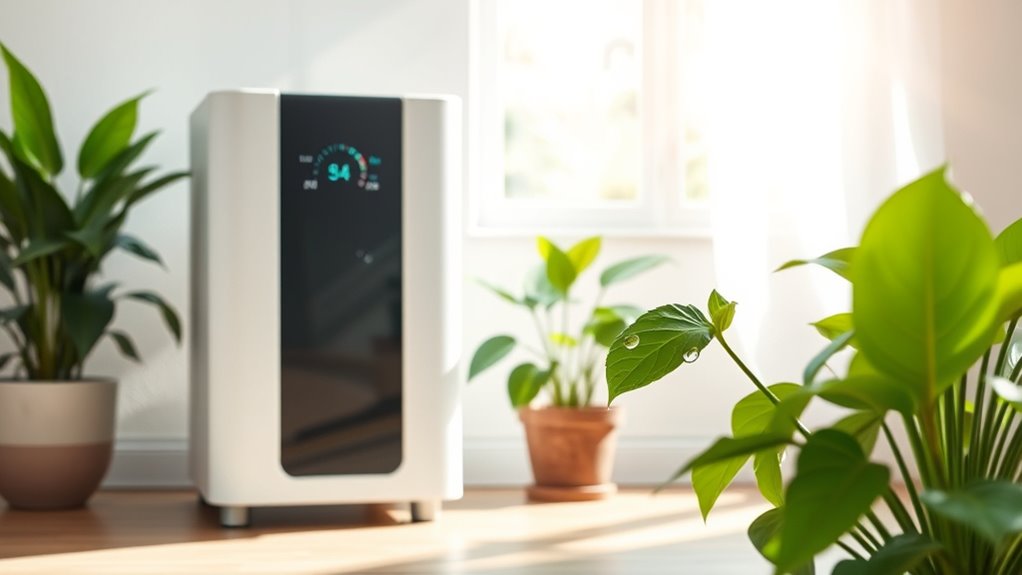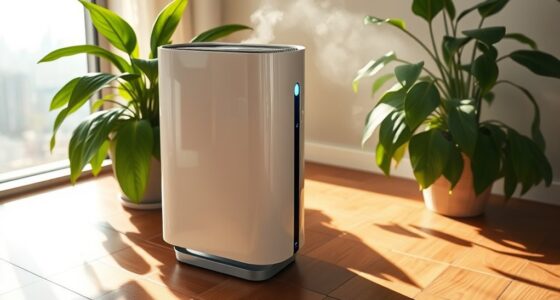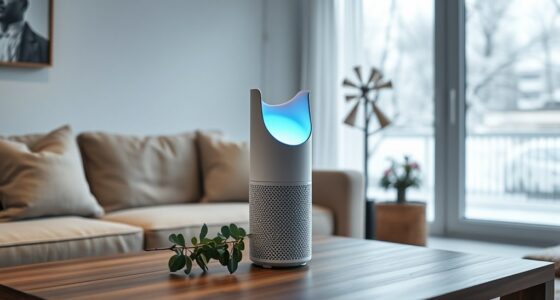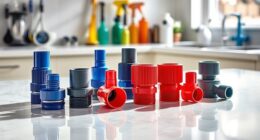Air purifiers improve indoor air quality by filtering out allergens and pollutants, but they don’t notably affect humidity levels. Many believe they dry out the air, but that’s a myth; any perceived dryness usually comes from increased air circulation. To maintain cozy humidity, you should consider using a humidifier alongside your air purifier. Learn how to optimize your indoor environment for both clean air and comfortable humidity levels to enhance your overall well-being.
Key Takeaways
- Air purifiers do not remove moisture from the air, so they do not directly affect indoor humidity levels.
- Increased air circulation from purifiers may create a sensation of dryness, but actual humidity remains unchanged.
- Ideal indoor humidity levels should be maintained between 30% to 50% for comfort and health.
- Using a humidifier alongside an air purifier helps maintain optimal humidity while improving air quality.
- Regular monitoring and adjustment of humidifier settings are essential for balancing humidity levels in conjunction with air purifiers.
Understanding Air Purifiers and Their Functionality
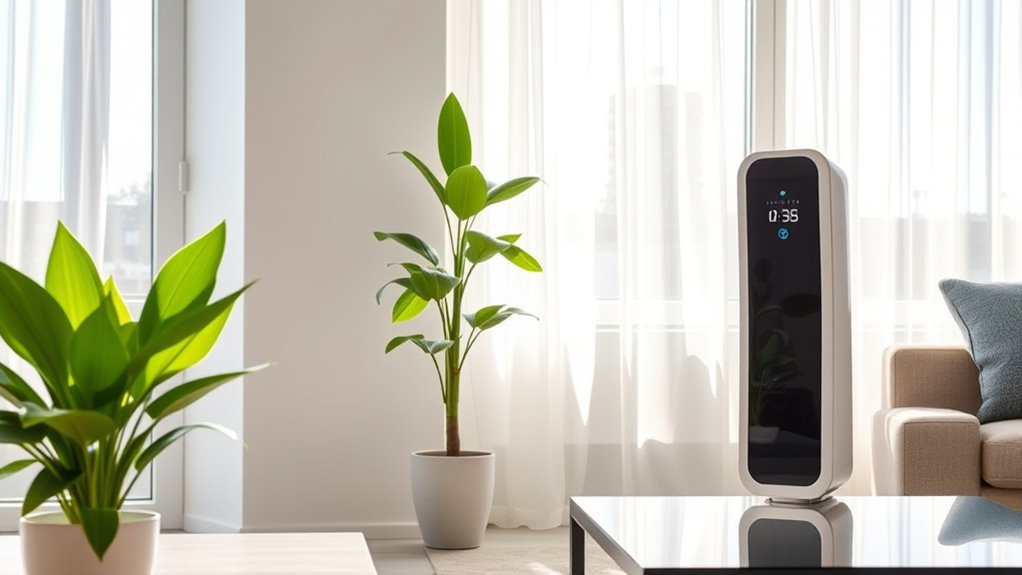
Air purifiers play an essential role in enhancing your indoor air quality, especially if you’re dealing with allergens or pollutants. They effectively remove airborne contaminants like dust, pollen, and pet dander through advanced filtration systems, primarily using HEPA filters. Additionally, many modern air purifiers include smart technology that enhances user convenience and efficiency. Regular filter replacement guidelines are critical to ensure the device operates at peak performance.
When you use air purifiers, they draw in air with a fan, filter out impurities, and release cleaned air back into your space. While they improve air circulation, it’s important to note that air purifiers don’t perform moisture removal, meaning they won’t considerably alter your indoor humidity levels. Understanding this distinction between air purification and humidity control is vital for maintaining peak air quality and comfort in your home. Regularly checking and cleaning filters is essential to guarantee you address both air quality and humidity needs effectively. Furthermore, choosing a model with room coverage size appropriate for your space ensures optimal purification performance. Additionally, HEPA filtration is crucial for capturing small particles effectively, ensuring better air quality. Choose devices wisely to ensure you meet both needs in your space.
The Myth of Air Purifiers Drying Out Indoor Air
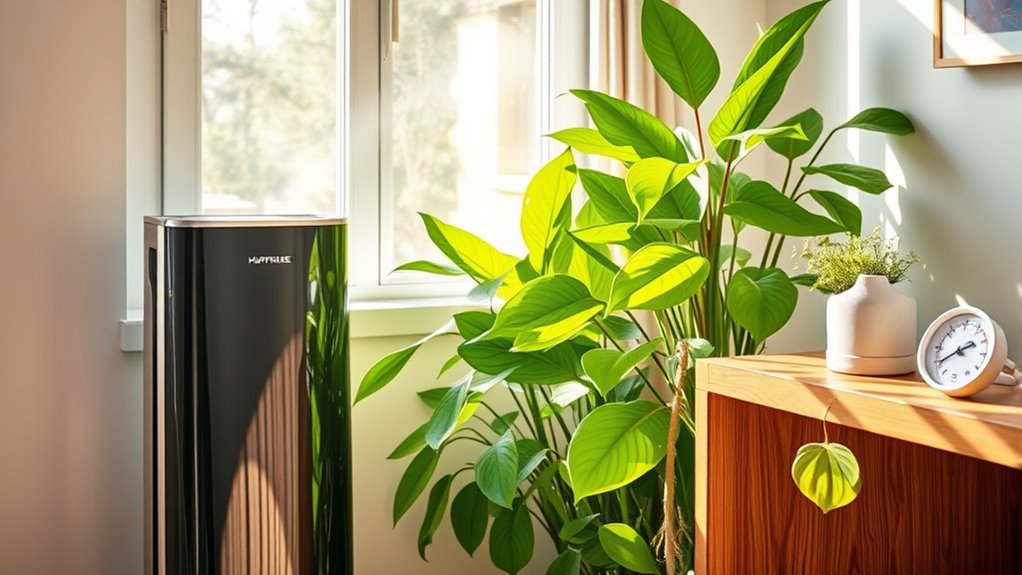
Using an air purifier can lead to some misconceptions about indoor humidity. Many believe that air purifiers dry out indoor air, but that’s simply not true—air purifiers don’t remove moisture.
Their main job is improving air quality by filtering pollutants with HEPA filters, which have no impact on humidity levels. The perception of dryness often comes from increased air circulation, which can enhance evaporation. In fact, maintaining good indoor air quality can significantly improve health outcomes, making the use of air purifiers essential for a healthier living environment. Additionally, HEPA filters are effective in reducing allergens such as dust and pollen, which can contribute to overall comfort in your living space. Regular maintenance of air purifiers, including filter cleaning and replacement, ensures they operate efficiently without compromising air quality. Furthermore, understanding the importance of hydration and nutrition is crucial in preventing feelings of fatigue that can arise in dry indoor environments.
To maintain ideal humidity, especially in dry conditions, you might need a humidifier. It’s essential to understand that humidifiers and dehumidifiers are the tools for controlling moisture, while air purifiers focus solely on cleaning the air. Additionally, indoor air quality can significantly impact your health, making the use of air purifiers essential for a healthier living environment.
How Air Purifiers Affect Indoor Humidity
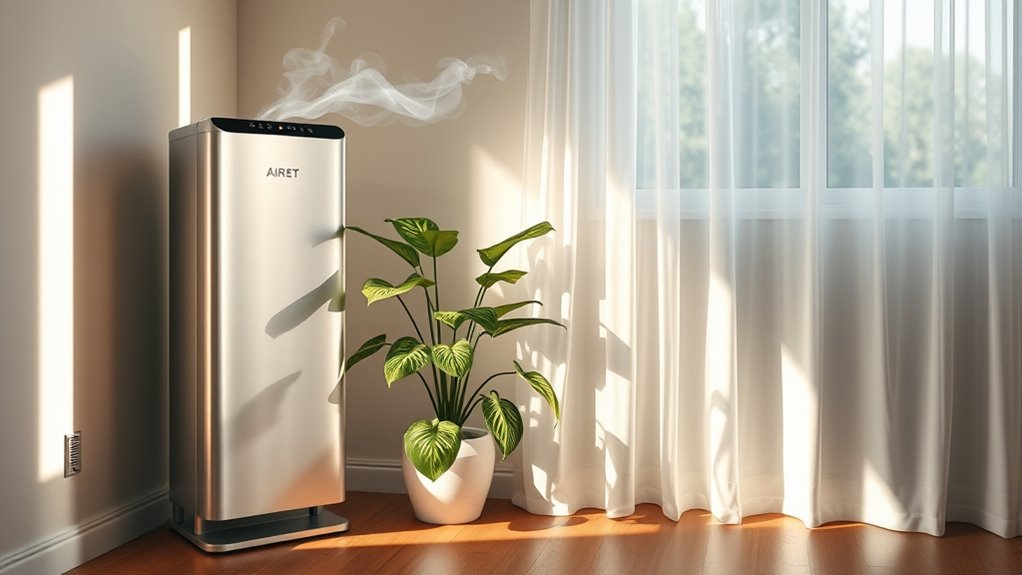
While you might notice a change in the feel of your indoor environment when running an air purifier, it doesn’t actually affect humidity levels.
Air purifiers, especially those with HEPA filters, are designed to filter out airborne contaminants without removing moisture from the air. They enhance air circulation, which can create the perception of dry air, but the actual indoor humidity remains unchanged. To maintain ideal humidity levels for your comfort and health, consider using a humidifier alongside your air purifier. This combination helps you achieve the perfect range of 30% to 50% relative humidity. Additionally, understanding the cost of home security systems can help you budget for other essential home appliances that improve your living environment. Incorporating best lifestyle products into your home can further enhance your overall comfort and air quality. Furthermore, utilizing energy-efficient systems like heat pumps can contribute to a more sustainable indoor environment. Using a humidifier along with your air purifier can help you reach the ideal humidity levels necessary for optimal indoor comfort. Additionally, maintaining proper energy efficiency in your home can lead to reduced energy consumption and lower utility bills.
Reasons the Air Feels Dry When Running an Air Purifier
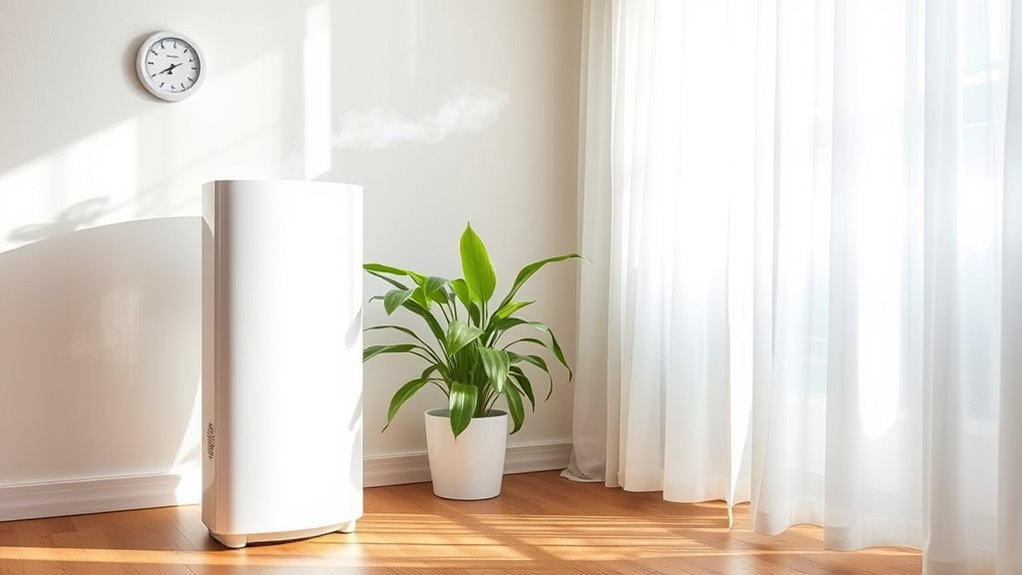
When you run an air purifier, you might notice the air feeling drier than usual. This sensation comes from the continuous air movement, which increases evaporation from surfaces in your home. As moisture evaporates, it can leave your skin and mucous membranes feeling less hydrated. Additionally, proper sealing mechanisms in air purifiers can enhance their efficiency, similar to how they work in coolers to maintain lower temperatures. This effect can be exacerbated in environments with high energy efficiency systems, which often limit natural humidity levels. Furthermore, the use of air purifiers can complement heat pump systems by improving indoor air quality, though it may also contribute to drier air conditions. To mitigate this issue, homeowners may consider maintaining adequate humidity levels to ensure comfort and health in their living spaces. Incorporating renewable energy sources into your home can help support a more sustainable environment while optimizing indoor climate control.
Continuous Air Movement
Air purifiers create continuous air movement that can make your home feel drier than it actually is.
While they filter and circulate air to improve air quality, this airflow can increase evaporation rates from surfaces, leading to dry air sensations. Your skin and mucous membranes may feel drier, contributing to discomfort, especially in indoor environments where heating systems already lower humidity.
Although air purifiers don’t remove moisture from the air, the perception of dryness can be strong. To enhance your comfort, consider using a humidifier alongside your air purifier. This combination can help maintain ideal humidity levels, ensuring you enjoy cleaner air without sacrificing moisture in your home. Additionally, being mindful of your budget for both devices can ensure you invest wisely in your health and comfort.
Increased Surface Evaporation
Continuous air movement from purifiers not only affects how we perceive humidity but also accelerates surface evaporation.
When you run an air purifier, the enhanced air circulation can lead to increased evaporation of moisture from your skin and mucous membranes. This results in a noticeable sensation of dryness, particularly in low-humidity environments.
While air purifiers don’t remove moisture from the air, they can create conditions that amplify the effects of dry air, especially during winter months.
To combat this dryness, consider using a humidifier to help maintain ideal humidity levels between 30-50%.
Tips for Maintaining Optimal Indoor Humidity With an Air Purifier
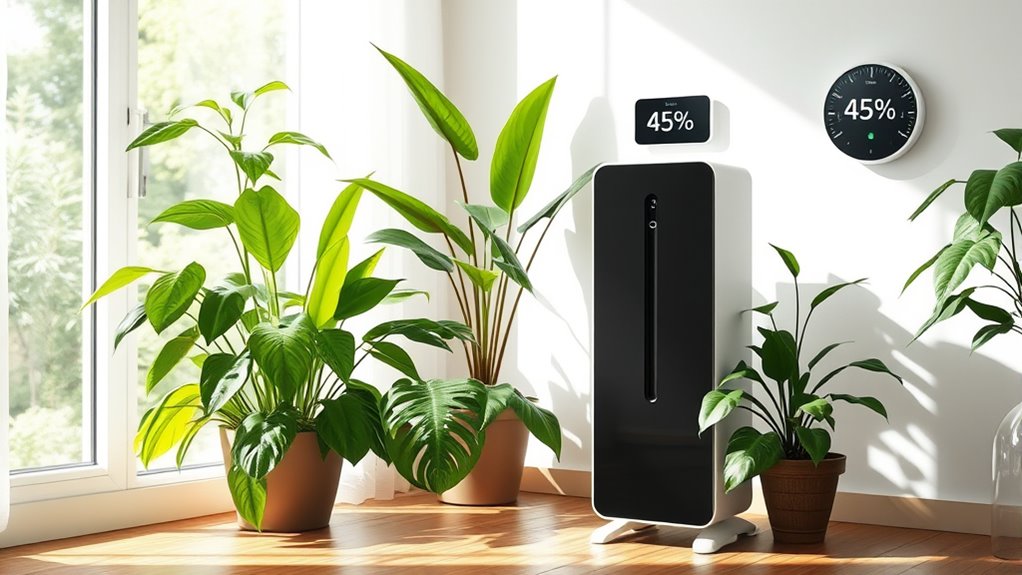
To keep your indoor humidity levels between 30-50% while using an air purifier, it’s essential to combine devices effectively.
Regularly monitor humidity with a hygrometer and adjust your humidifier as needed.
Don’t forget to maintain your air purifier’s filters to guarantee ideal airflow and comfort.
Combine Devices Effectively
While managing indoor air quality, it’s vital to combine devices effectively to maintain ideal humidity levels.
Place your air purifier and humidifier in the same room but at opposite ends. This setup helps guarantee even moisture distribution and optimal indoor humidity.
Regularly adjust your humidifier settings to keep humidity between 30% and 50%, which is essential for your comfort and health.
Consider using a hygrometer to monitor humidity levels, allowing you to fine-tune both devices as needed.
Don’t forget about your air purifier’s filters; maintaining them prevents overworking the unit and guarantees efficient operation alongside your humidifier.
Together, these devices can greatly enhance air quality while preventing dryness often linked to air purification.
Monitor Humidity Levels
Maintaining ideal indoor humidity levels is key to enhancing your comfort and health, especially when using an air purifier. Start by regularly monitoring your humidity levels with a hygrometer, ensuring they stay between 30% and 50%. This range promotes optimal humidity and air quality.
Place a humidifier in the same room as the air purifier but at opposite ends to encourage even moisture distribution and clean air. Adjust your humidifier settings to maintain those humidity levels without creating excess moisture.
During dry seasons, combining an air purifier with a humidifier can alleviate the dryness caused by consistent air circulation.
Finally, don’t forget to clean your air purifier’s filters regularly to keep it performing efficiently and supporting your indoor humidity goals.
Regular Maintenance Practices
Maintaining ideal indoor humidity levels requires regular maintenance practices that complement your air purifier‘s function.
Remember, air purifiers don’t remove moisture, so you should combine the use of a humidifier to maintain optimal humidity, especially during dry seasons.
Regularly monitor indoor humidity levels with a hygrometer, aiming for a range of 30% to 50%.
Position your humidifier and air purifier at opposite ends of the room to balance humidity effectively.
Adjust humidifier settings to keep humidity within that ideal range, preventing your air purifier from overworking.
Additionally, perform routine maintenance on air purifiers by cleaning and replacing filters according to the manufacturer’s recommendations to enhance indoor air quality and guarantee efficient operation.
The Role of Humidifiers and Dehumidifiers in Indoor Air Quality

Humidity plays an essential role in your indoor air quality, as both humidifiers and dehumidifiers help create a comfortable living environment.
Maintaining balanced humidity levels between 30% and 50% is vital for your comfort and health. Here’s how they contribute:
- Humidifiers add moisture, alleviating dryness and preventing respiratory issues, especially in winter.
- Dehumidifiers remove excess moisture, reducing humidity over 50% to inhibit mold growth and allergens like dust mites.
- Monitoring indoor humidity with a hygrometer guarantees you’re using these devices effectively, promoting ideal air quality.
Choosing the Right Air Purifier for Your Home
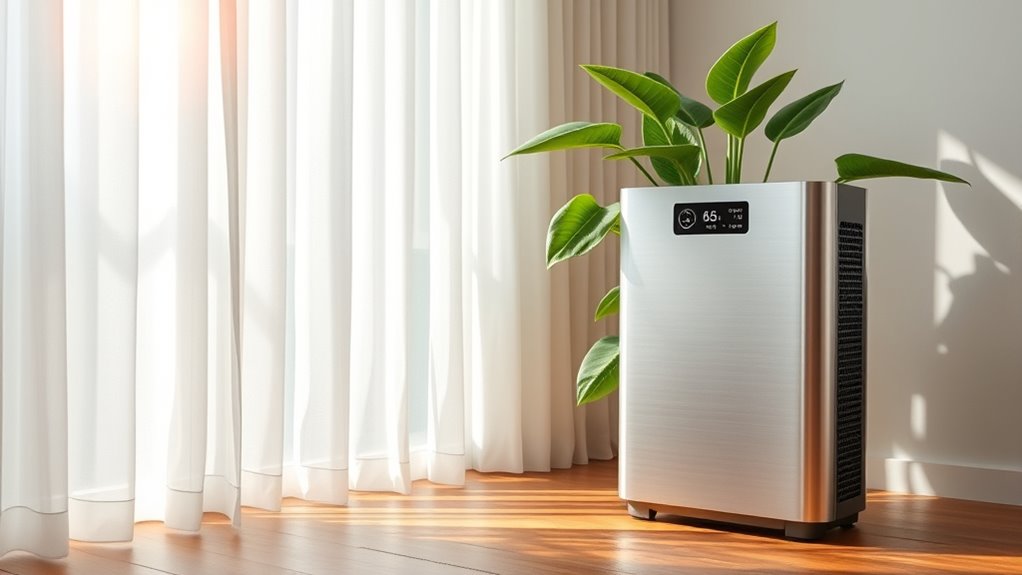
Finding the right air purifier for your home can greatly enhance your indoor air quality, complementing the work of humidifiers and dehumidifiers.
Start by choosing models equipped with HEPA filters, which efficiently capture airborne allergens without affecting humidity levels. If odors or chemical vapors are a concern, consider air purifiers with activated carbon filters for a thorough air purification solution.
Choose air purifiers with HEPA filters for allergen capture and activated carbon filters for odors and vapors.
Check the Clean Air Delivery Rate (CADR) to guarantee the purifier matches your room size; higher CADR ratings indicate better efficiency.
Features like air quality sensors can monitor and adjust operations based on real-time data, boosting effectiveness.
Achieving Comfortable, Clean Air With an Air Purifier
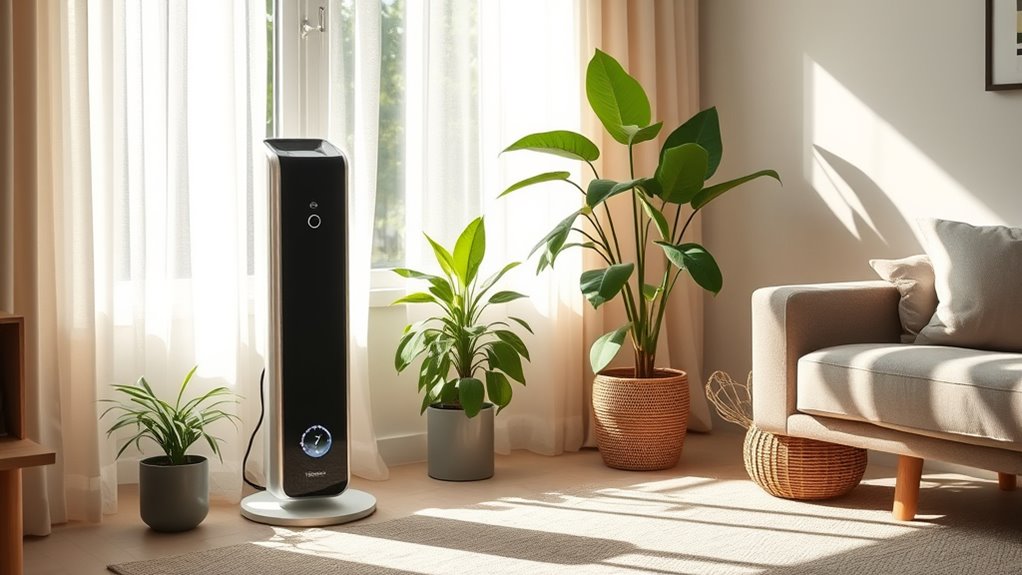
While air purifiers excel at removing airborne contaminants like dust and allergens, they can also contribute to your overall comfort by enhancing the quality of the air you breathe.
To achieve comfortable, clean air, consider these tips:
- Use a humidifier: Pairing a humidifier with your air purifier helps maintain ideal humidity levels, especially in dry seasons.
- Monitor humidity levels: Utilize a hygrometer to keep humidity between 30% to 50% for a balanced indoor environment.
- Maintain your air purifier: Regularly replace filters and clean the unit to guarantee it operates efficiently, supporting your health and well-being.
Frequently Asked Questions
Do Air Purifiers Affect Humidity?
Air purifiers don’t affect humidity levels in your home. They’re designed to remove airborne contaminants but lack the ability to remove moisture from the air.
While you might feel drier air due to improved circulation, that doesn’t mean the humidity is actually changing.
To maintain comfortable humidity, especially in dry seasons, consider using a humidifier alongside your air purifier.
Keeping humidity between 30% and 50% is vital for your comfort and health.
Does Air Filter Affect Humidity in House?
No, air filters don’t affect humidity in your house.
They’re designed to remove airborne particles, not moisture.
While you might feel drier air due to improved circulation, these filters won’t actually change the water vapor levels.
If you’re looking to maintain ideal humidity, you’ll need to use a humidifier or dehumidifier.
Aim for a relative humidity between 30% and 50% for a comfortable indoor environment, separate from your air filtration efforts.
What Are the Disadvantages of an Air Purifier?
Using an air purifier can feel like trying to catch smoke with your bare hands; it helps but leaves some things behind.
One major disadvantage is the cost of constant filter replacements, which can add up quickly. You might also notice that they create a perception of dryness, leading to discomfort like dry skin.
Plus, they can be noisy, disrupting your peace, especially in quiet moments.
Will an Air Purifier Affect a Humidifier?
An air purifier won’t negatively affect your humidifier.
In fact, using both together can enhance your indoor air quality. While the air purifier filters out contaminants, your humidifier adds moisture, keeping humidity levels ideal.
Their combined use is especially helpful during dry seasons, guaranteeing you breathe cleaner air without sacrificing comfort.
Just remember to maintain both devices regularly to make certain they work effectively together and provide the best environment for you.
Conclusion
In summary, while air purifiers excel at improving air quality, they don’t necessarily dry out your indoor air. Instead, they can coexist with humidifiers to create a balanced environment that feels fresh yet comfortable. So, don’t shy away from using an air purifier just because you worry about humidity levels. Embrace the blend of clean air and ideal moisture, ensuring your home remains a haven of health and comfort.
